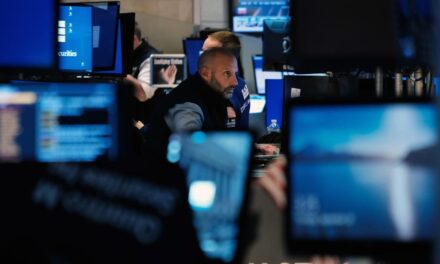
‘A Very Big Problem.’ Giant Ship in the Suez Remains Stuck.
MANSHIYET RUGOLA, Egypt — The gargantuan container ship that has blocked world trade by getting stuck aslant the Suez Canal has towered over Umm Gaafar’s dusty brick house for four days now, humming its deep mechanical hum.
She looked up from where she sat in the bumpy dirt lane and considered what the vessel, the Ever Given, might be carrying in all those containers. Flat-screen TVs? Full-sized refrigerators, washing machines or ceiling fans? Neither she nor her neighbors in the hamlet of Manshiyet Rugola, population 5,000-ish, had any of those at home.
“Why don’t they pull out one of those containers?” joked Umm Gaafar, 65. “There could be something good in there. Maybe it could feed the town.”
The Japanese-owned Ever Given and the nearly 300 cargo ships now waiting to traverse the Suez Canal, one of the world’s most critical shipping arteries, could supply Manshiyet Rugola many, many times over.
Hauling cars, oil, livestock, laptops, jet fuel, scrap metal, grain, sweaters, sneakers, appliances, toilet paper, toys, medical equipment and much more, the vessels were supposed to supply much of the world, and the canal was to have been their quickest path from Asia and the Middle East to Europe and the east coast of the United States.
A shipping agent at the canal said on Saturday morning that dredgers had managed to dig out the rear of the ship, and a spokesperson for the Suez Canal Economic Zone posted on Facebook that the ship’s rudder had been freed. But as a salvage team and canal authorities continued struggling to dislodge the four-football-field-long leviathan from the sand bank where it ran aground on Tuesday, blocking all shipping traffic through the canal, global supply chains churned closer to a full-blown crisis.
Already, shipping analysts estimated, the colossal traffic jam was holding up nearly $10 billion in trade every day.
“All global retail trade moves in containers, or 90 percent of it,” said Alan Murphy, the founder of Sea-Intelligence, a maritime data and analysis firm. “So everything is impacted. Name any brand name, and they will be stuck on one of those vessels.”
Easing the bottleneck depends on the salvagers’ ability to clear away the sand and mud where the Ever Given is stuck and to lighten the ship’s load enough to help it float again, all while tugboats try to push and pull it free. Their best chance may arrive on Monday, when a spring tide will raise the canal’s water level by up to about 18 inches, analysts and shipping agents said.
On Friday, the company that oversees the ship’s operations and crew, Bernhard Schulte Shipmanagement, said more and larger tugboats had arrived to help, with two more due on Sunday. Several dredgers, including a specialized suction dredger that can extract 2,000 cubic meters of material per hour, were digging around the vessel’s bow, which is wedged into the canal’s eastern bank, the company said. It added that high-capacity pumps would begin to pump water from the vessel’s ballast tanks to lighten the ship.
A video taken from the ship and provided by Mohammed Mosselhy, the owner of First Suez International, a maritime logistics company at the canal, showed several excavators digging steadily at the edge of the turquoise water near the ship’s bow.
The team of eight Dutch salvage experts and naval architects overseeing the operation will need to survey the ship and the seabed and create a computer model that will help it work around the vessel without damaging it, said Capt. Nick Sloane, a South African salvage master who led the operation to right the Costa Concordia, the cruise ship that capsized in 2012 off the coast of Italy.
They will need to clear other vessels from the area, a massive coordination effort. And they will need to account for the possibility that the Ever Given’s grounding has rearranged the seabed, making it harder for other ships to pass through the area even after it has been moved, said Capt. Paul Foran, a marine consultant who has worked on other salvage operations.
All the while, they must hope the Ever Given remains intact. With the ship sagging in the middle, its bow and stern both caught in positions for which it was not designed, the hull is vulnerable to stress and cracks, both experts said.
Mr. Mosselhy said teams of divers were already inspecting the hull and had not yet found damage. But in most other respects, the Ever Given had succumbed to Murphy’s Law: Everything that could go wrong did, starting with the ship’s size, among the world’s largest.
“It was the biggest ship in the convoy, and she ended up in the worst part of the canal” — a narrow section with only one lane, Captain Sloane said. “And that was just really unfortunate.”
If the tugboats, dredgers and pumps cannot get the job done, they could be joined by a head-spinning array of specialized vessels and machines requiring perhaps hundreds of workers: small tankers to siphon off the ship’s fuel; the tallest cranes in the world to unload some of its containers one by one; and, if no cranes are tall enough or near enough, heavy-duty helicopters that can pick up containers of up to 20 tons — though no one has said where the cargo would go. (A full 40-foot container can weigh up to 40 tons.)
Capt. Sloane estimated that the operation would take at least a week. When a similarly sized ship, the CSCL Indian Ocean, ran aground near the port of Hamburg in 2016, it took nearly six days to clear the Elbe River.
All this because, to put it simply: “This is a very big ship; this is a very big problem,” said Richard Meade, the editor in chief of Lloyd’s List, a London-based maritime intelligence publication. “I don’t think there’s any question they’ve got everything they need. It’s just a question of, it’s a very big problem.”
If the ship breaks free by Monday, the shipping industry can absorb the inconvenience, analysts said, but beyond that, supply chains and consumers could start to see major disruptions.
Some ships have already decided not to wait, U-turning out of Suez to take the long way around the southern tip of Africa, a journey that could add weeks to the journey and cost more than $26,000 per extra day in fuel costs.
In Manshiyet Rugola, whose name translates to “Little Village of Manhood,” traffic jams of any kind would be difficult to imagine in usual times.
Donkey carts piled high with clover bumped down semi-paved lanes between low brick houses and green fields lined with palm trees, trash and animal dung. A teenager hawked ice cream from his motorcycle. Roosters offered profane competition to the noontime call to prayer. Until the Ever Given showed up, the minarets of the unimposing mosques were the tallest structures around.
“Do you want to see the ship?” a young boy asked a pair of visiting journalists, bobbing in excitement under the window of their car. Ever since the earthquake-like rumble of the ship running aground jolted many awake around 7 a.m. Tuesday, the Ever Given had been the only topic in town.
“The whole village was out there watching,” said Youssef Ghareeb, 19, a factory worker. “We’ve gotten so used to having her around, because we’ve been living on our rooftops just watching the ship for four days.”
It was universally agreed that the view was even better at night, when the ship glowed with light: a skyscraper right out of a big-city skyline, lying on its side.
“When it lights up at night, it’s like the Titanic,” said Nadia, who, like her neighbor Umm Gaafar, declined to give her full name because of the security forces in the area. “All it’s missing is the necklace from the movie.”
Umm Gaafar had asked to go by her nickname so as not to run afoul of the government security personnel who had passed through, warning residents not to take photos of the canal and generally spreading unease. Nadia said she was too intimidated to take pictures of the ship at night, though she badly wanted to.
Villagers and shipping analysts had the same question about the Ever Given, if rooted in different expertise. The ship’s operators have insisted that the ship ran aground because of the high winds of a sandstorm, with the stacked containers acting like a giant sail, yet other ships in the same convoy passed through without incident. So had previous ships in previous storms, the villagers pointed out.
“We’ve seen worse winds,” said Ahmad al-Sayed, 19, a security guard, “but nothing like that ever happened before.”
Shipping experts said the wind might well have been the major factor, exacerbating other physical forces, but suggested that human error may also have come into play.
“I am highly questioning, why was it the only one that went aground?” Captain Foran said. “But they can talk about all that later. Right now, they just have to get that beast out of the canal.”
Nada Rashwan contributed reporting.

















